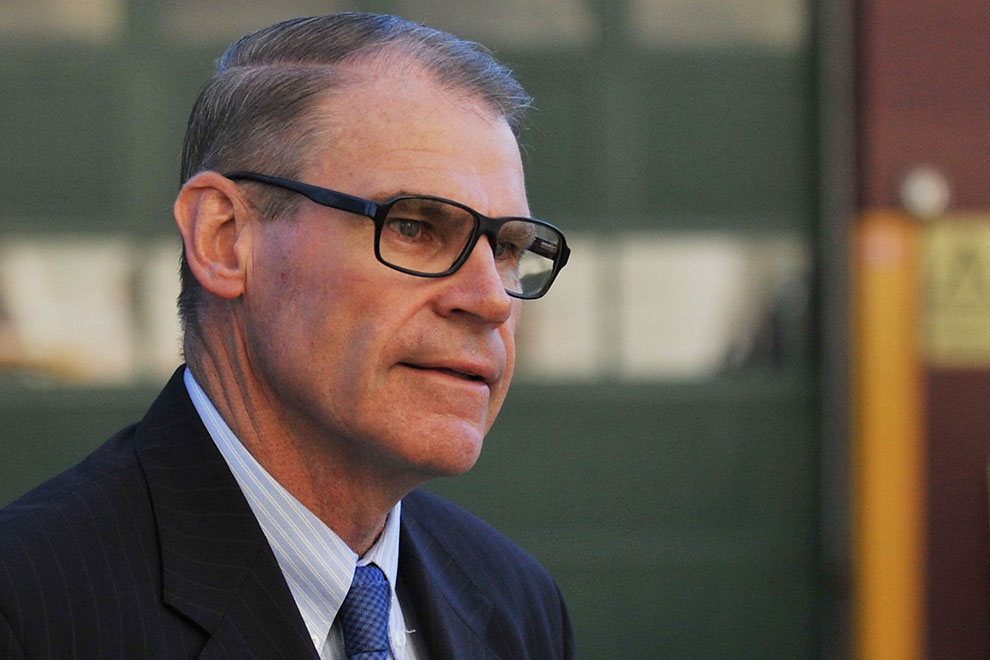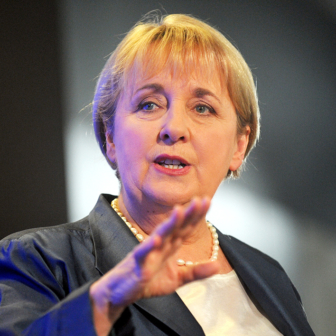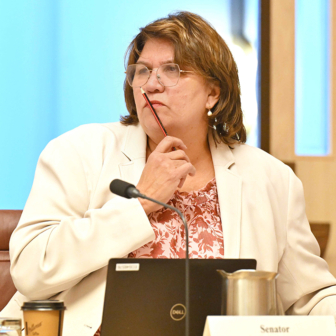Every winter the strange tribe that is the NSW branch of the Australian Labor Party gathers for its state conference, usually in Sydney’s gloomy, echoing town hall. There it enacts a series of time-worn rituals before descending the marble steps, en masse, to get lunch, go to the pub or catch the train home.
There is a timeless, unchanging rhythm to this annual meeting of the clans. The state leader makes a speech on the Saturday; the federal leader holds forth on the Sunday morning; and pretty much every year there is a debate about the rules that govern this famously voluble organisation.
And this year tradition was gloriously upheld.
State leader John Robertson spoke optimistically about Labor’s hopes in New South Wales – and received the traditional standing ovation. Federal leader Bill Shorten spoke more realistically about Labor’s hopes in Canberra – and received the traditional standing ovation. And the much respected, and soon to retire, Labor stalwart John Faulkner initiated a debate about making his party more democratic – and received the traditional kick in the teeth.
Faulkner joined the Labor Party when he was a teenager. He found a political hero in the form of Gough Whitlam. He became a member of the party’s Left. And then he pretty much dedicated his life to Labor.
In 1980 he became the assistant general secretary of the NSW branch, the Left faction’s highest position on the NSW executive, and for nine years he toiled away at Sussex Street alongside his factional enemies in the Right. He wasn’t always invited to the office Christmas parties.
In 1989 he became a senator, and later a minister under both Keating and Rudd. He is now Australia’s longest-serving senator. He is famously taciturn with the media, can be quite savage in Senate estimates, and is a passionate and persuasive backroom operator. It’s a widely held view that he’s a man of considerable personal integrity. When he retires from the Senate at the next election he will leave a gaping hole in a federal caucus that is not over-endowed with talent.
Interestingly for a machine politician, Faulkner has long been in favour of sharing power more widely in the party. As a hardened warrior for the Left, this could seem like a transparent attempt to boost the chances of his faction, but all indications are that Faulkner’s desire for reform in this area is wholly genuine.
What he desired at this year’s state conference was a change to the rules that govern how NSW Labor preselects its candidates for upper house positions. Not such a big deal, you might think.
In New South Wales, rank-and-file branch members already get a say in lower house preselections (though these votes can be overturned by head office, and often are – but that, as they say, is another story). Currently, however, a preselection for either the Senate or the NSW Legislative Council is decided entirely by party powerbrokers. It’s not a vote; it’s a deal. Why, Faulkner wanted to know, shouldn’t the rank-and-file have some sort of say in who might represent the Labor cause in the upper house?
Faulkner sports an old-fashioned short-back-and-sides haircut; he has a big jaw and a big frame and he wears old-fashioned glasses. As he walked up to the microphone on Saturday he looked to me more like a member of Ben Chifley’s 1949 cabinet than a senator from the twenty-first century.
As he has done many times before, Faulkner stood at the lectern at the very centre of the hall, surrounded by almost 900 seated delegates, and made his case. He reminded delegates that former Labor MPs Eddie Obeid, Ian Macdonald and Tony Kelly, each of whom had been exposed as corrupt, had all occupied seats in the NSW upper house courtesy of Labor machine politics. “It’s our responsibility to change the system that inflicted them, not only on our party, but on the people of New South Wales,” he told the conference.
He pointed out how inconsistent it was for rank-and-file members to have a say in who would become the party’s national leader under new rules brought in by former PM Kevin Rudd, yet they couldn’t have a say in who scored a spot on Labor’s Senate ticket. He called on the delegates to vote for what was in the party’s interest, not simply in their factional interest. His point was clear: a hollow system will tend to elect hollow men (and women).
Of course, he knew he never had a chance. He knew it as he walked to the microphone. He knew it weeks, even months, ago.
The whole structure of the state conference is a song of joyful praise to factionalism. The nearly 900 delegates are drawn from three sources: the state electoral councils, the federal electoral councils, and the affiliated unions. If your faction controls the majority of branches in a state or federal electorate, that faction controls who goes to conference as an SEC or FEC delegate. If your faction controls a trade union, it’s this faction that controls who goes to conference as that union’s delegates.
Now, the factional alignment of the unions in New South Wales hasn’t changed substantially in decades. The Transport Workers Union is a citadel of Centre Unity, the posh, self-ascribed name of the NSW Right; the Australian Manufacturing Workers Union is a bastion of the Left. All the other affiliated unions have longstanding factional relationships.
Similarly, different electorates, state and federal, are controlled (and defended) by different factions. And the whole system has been in this hard-won equilibrium for decades. There are, of course, divisions and betrayals within the two main factions, and deals across the factions, but in the main the Left controls about a third of the delegates, and the Right controls the rest – and therefore holds sway.
And this is why there is so much empty theatre at Labor conferences. Everything is stitched up behind the scenes before a vote is even taken. Other than making a name for yourself, or displaying factional loyalty, the speeches on the floor are not expected to galvanise change. The usual point of oratory is to persuade someone to change his or her mind. None of the delegates sitting on the little red chairs in Sydney’s historic town hall is allowed to follow his or her own inclinations – just like jockeys, they’ve all been given their riding instructions. Even Cicero himself would die a death in this forum.
Faulkner, of course, understands all this – and he also understands that the politics of symbolic gesture is sometimes all you’ve got. As he told the delegates that day, “I know that this amendment is going to be slaughtered here on the floor of this party conference… Let’s be honest – those who run the show will never give up their power.”
The Labor Party has reformed a great many things in Australia – the economy, the health system, universities and foreign policy – but it has never really reformed itself. Even Kevin Rudd’s much-vaunted changes to how the national leader is elected still leave 50 per cent of voting power in the hands of federal caucus – and therefore indirectly in the hands of the apparatchiks and union leaders who have power over caucus.
The one-time Labor leader and now full-time Labor maverick Mark Latham would go even further than Faulkner. When it comes to the election of the parliamentary leader, Latham would give rank-and-file members 100 per cent of the voting franchise – bugger the idea of giving any extra power to the caucus. He would allow the leader to select the front bench, in the same way a Coalition leader can. He also advocates using community preselections to choose Labor’s candidates – in effect, a type of small-scale US-style primary. And most controversially of all, given his druthers, Latham would reduce trade union representation at party conferences from 50 per cent to something commensurate with union coverage in the workforce – which is currently about 20 per cent. This is what’s known as the politics of the wishlist.
I can only think of one extra, even more controversial reform: the rank-and-file election of all party officers. It’s claimed there are 17,000 Labor members in New South Wales, but only about seventeen make the real decisions about who gets what. Maybe the 17,000 should start directly electing those seventeen.
In the end, Faulkner’s amendment was defeated on a show of hands. But the conference did adopt a proposal to elect its next state leader using the national model introduced by Kevin Rudd in 2013 – so the senator might have derived some grim satisfaction from the weekend’s work. •




